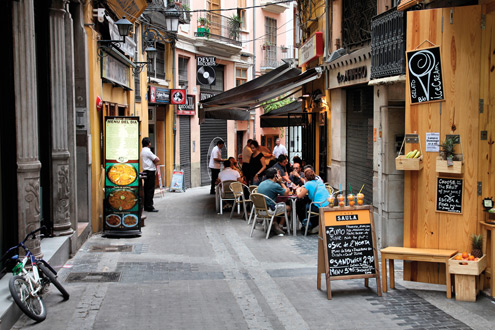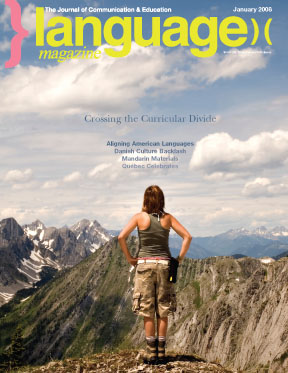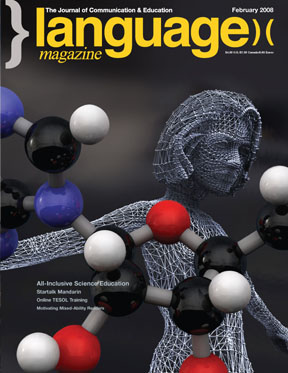Language Magazine journeys to the places around the globe where Spanish can best be learned
There are as many reasons to learn Spanish as there are places to learn it:
Spanish is spoken by at least an estimated 350 million people around the world and is currently the 4th most commonly spoken language worldwide. Geographically, a large number of countries speak Spanish: Spain, the U.S., Mexico, the Philippines, Colombia, Costa Rica, Venezuela, Argentina, Chile, Equatorial Guinea, Guatemala, Honduras, Nicaragua, Ecuador, Peru, Cuba, the Dominican Republic, Puerto Rico, Panama, Bolivia, Paraguay, and Uruguay. Knowing Spanish opens the door for you to communicate with 1/3 of a billion speakers worldwide.
If you live in the U.S., it is possible to maintain almost daily contact with native Spanish speakers in many cities or even in rural areas. This is certainly the case in the many states bordering Mexico, or such states as Florida and New York where there are many immigrants of Cuban heritage. Even if your home state is not located in one of these areas, there is still a great likelihood of finding Spanish-speakers close to where you live, which is perhaps why over half of all students learning languages in U.S. colleges and universities choose Spanish over other languages.
Internationally, people who speak Spanish often have opportunities to work in trade or business fields. Other options include diplomacy, interpretation, and security applications, which all require a sensitivity to and proficiency in another language. Furthermore bilingual employees often receive a larger salary than their non-Spanish speaking counterparts.
Places to Learn Spanish
Spain
Fundación San Millan
The Monasteries of Suso and Yuso in San Millán de la Cogolla, a UNESCO world Heritage Site, owe their international fame to the fact that they form the cradle of the Spanish language.
To continue the historic task of spreading knowledge of the language, a modern language center, Centro de Investigación (Cilengua) has been created so that nationally and internationally acclaimed scholars can develop various projects related to the Spanish language.
The Center also offers well-designed Spanish language and culture programs combined with an attractive tourist program, covering gastronomy, history, culture and a the incomparable, world-famous vineyards of La Rioja.
Universidad de Granada
The Centro de Lenguas Modernas is part of the prestigious University of Granada in southern Spain. It offers Spanish Language and Culture Courses throughout the year taught by highly qualified professionals in a unique setting, halfway between snow-capped mountains and subtropical beaches. Here foreign students enjoy a singular multicultural and multilingual atmosphere, sharing their daily lives with Spanish students learning other languages, thus stimulating a mutual interest in their different languages and cultures. Granada’s vitality and riveting history are reflected in its 70,000 university students and the spectacular Alhambra Palace declared a World Heritage Site by the UNESCO in 1984.”
Universidad Francisco de Vitoria
Universidad Francisco de Vitoria (Madrid, Spain) forms part of a private, non-profit Foundation. Fully accredited by the Spanish Ministry of Education and Local Madrid Government, UFV offers 19 undergraduate degrees in eight academic areas. As a Catholic institution, the university distinguishes itself by offering individualized attention to students, its dedication to social awareness through service learning and core curriculum courses in the humanities and leadership. Semester study abroad programs combine Spanish language study with classes on offer in the regular academic offer. UFV’s four-week Intensive Spanish Language and Culture Course and the Hispanic Studies for Heritage Learners Program are other dynamic programs regularly offered.
The Universidad Carlos III de Madrid offers semester, intensive and yearlong intensive Spanish courses for all international students who wish to learn to learn or improve their knowledge of Spanish during their stay at the university.
All courses are based on the Common European Framework of Reference for Languages (CEFR) and are characterized by the student being at the center of the learning process; highly-qualified teaching staff; a variety of methods to respond to diversity in the classroom; small-group learning; and guided self-learning outside the classroom.
Universidad de Salamanca
Each year, thousands of students come to Salamanca to learn Spanish, turning this city into a point of reference as far as language tourism is concerned.
Salamanca is a vibrant, friendly, dynamic, safe and well-looked after city. The prestige and tradition of its university, one of the oldest in Europe, along with its accredited teaching centers make it the perfect destination to learn Spanish. It’s no coincidence therefore that the University of Salamanca is in charge of the DELE certification, an examination that is sat in over 50 countries and issued by the Spanish Ministry for Education.
Cursos Internacionales de la Universidad de Salamanca offers language and culture courses year-round at all levels with different cultural content so students can customize programs to meet their needs.
As well as general and group courses, there are programs for teachers (Másteres en Lengua y Cultura Españolas y en la Enseñanza del Español como Lengua Extranjera).
Burgos University
Ten reasons to study Spanish at the University of Burgos
1. To enjoy the familiar atmosphere of a Spanish University.
2. A safe, green city with good communications brimming art and tradition
3. Qualified and dynamic teaching staff.
4. Individual attention and tutors.
5. Great variety of workshops, cultural visits and activities.
6. Modern facilities with Wi-Fi areas, computer rooms, library and sports.
7. Possibility to prepare for the DELE exams of the Instituto Cervantes
8. Combine learning Spanish with taking graduate courses at University
9. Special programs for groups
10. Accommodation with families, University Dorms or shared flats
Santiago de Compostela University
International Courses at USC has organized, for more than sixty years, Spanish language courses for students wishing to learn and perfect the language, while experiencing the Spanish culture. Courses take place all year round and students can choose the one that suits best and even join in the Road to Santiago Course, combining a multi-angle approach to the study of the Road to Santiago and the improvement of Spanish language skills while experiencing the magic of the centuries-old pilgrimage.
Fundacion Comillas
Fundacion Comillas is internationally renowned in the teaching, research and dissemination of the Spanish Language and its Culture. Associated to the University of Cantabria, its prestige is strengthened by its sponsors.
The Comillas Foundation offers a unique opportunity to learn Spanish and to enjoy Spanish culture in an exceptional, different and privileged setting:
• Classrooms in an impressive modernist 19th century building
• Area of undeniable beauty bathed by the Cantabrian Sea and surrounded by the impressive Picos de Europa.
1st class teaching:
• University Degree and Postgraduate studies
• Spanish courses for Teachers, students and professionals.
Universidad Nebrija
Universidad Nebrija is a prestigious private university, known as a modern and innovative institution. Its international approach creates a stimulating and friendly atmosphere in an ideal location in Madrid. With three decades of experience in teaching and research of Spanish as a Foreign Language, Nebrija offers its students a unique way to learn Spanish. Students may choose between the Hispanic Studies Program with Language, Conversation, Culture and Literature and the Spanish Plus Program, combining Spanish courses and others taught in English in different areas: Business, History, Art and European Studies. Spanish language and culture courses are offered at all levels.
Idiomas Católica — PUCP Spanish Program
The Spanish program is open all year long. Every month, two-hour courses are available to students at different levels: Basic, Intermediate and Advanced.
In each of these interactive courses, the student is exposed to the use of practical, effective, real-life language and to the Spanish speaking culture. Sympathetic staff help students acquire the necessary structures and contents of grammar, pronunciation, vocabulary, language functions to make them fully competent in the spoken language.
Universidad Rey Juan Carlos
The Rey Juan Carlos University, created in 1996, is the most modern of all the public universities in Madrid. It has four campuses, located in Móstoles, Alcorcón, Fuenlabrada and Vicálvaro. This university currently has an enrolment 30,000 students
The Rey Juan Carlos University offers a large variety of official and special degrees, Masters and continuing education programs in Spanish and (seven degrees in English).
This university specializes in Health Sciences, Communication Sciences, Telecommunication Engineering, Tourism, and Social and Legal Sciences.
This university participates in Mobility Programs for Students and the University Language Centre teaches French, German, Italian, Chinese, Portuguese and Spanish.
University of Deusto | International Spanish Center (CIDE)
The International Spanish Center, located in Bilbao, organizes academic year, semester and summer programs specially designed for international students in the areas of Spanish language, culture, international relations and business. Programs include a large variety of services such as cultural visits, academic and personal advising, housing reservations, medical insurance, and internships.
Costa Rica
CPI Spanish Immersion School
CPI Spanish Immersion School has been offering quality Spanish immersion courses since 1991 at the best locations in Costa Rica: Heredia Central Valley, Monteverde Cloud Forest and Flamingo Beach. Students may divide their time between three distinct campuses without sacrificing quality or continuity. A variety of programs, each with small class size, have been designed for all ages and all levels. The arrangement of accommodations (homestays, apartments and student residencies), the availability of academic university credits, along with bilingual staff providing personalized service to students through the organization of volunteer programs and excursions makes CPI one of the best study abroad options in Costa Rica.
CPI has designed a variety of professional seminars, of which one of the most popular is the workshop for teachers of Spanish as a foreign language. Seminar participants are taught various techniques created, developed, and successfully applied during many years of experience as an institution that specializes in Spanish as a second language. The teachers who participate in this seminar leave prepared to step into the classroom with various instructional techniques that can easily be modified to meet the needs of any type of student.
Another important service at CPI is the Groups Division which has been custom creating itineraries and hosting groups of up to 70 students for over 10 years. Groups range from primary school children to senior citizens, and they host several high school and university groups, most of which return on an annual basis.
Argentina
Intercultural Institute
Intercultural Institute in Mendoza and San Juan in west-central Argentina is an excellent option for those who want to study in a safe, friendly city which is not only one of the world’s wine capitals but also a center for adventure tourism. Intercultural has focused on specific Spanish courses and culture, with a set of thematic modules that can respond to special needs for groups that perform major or minor in Spanish. All courses have the possibility to earn credits for universities. It also places internships in tourism, industry, wine, marketing and international trade.
Mexico
Teacher’s Summer Language Academy
Teacher’s Summer Language Academy Mexico provides accredited immersion opportunities for teachers including leveled Spanish learning, with a curriculum developed especially for classrooms. Teachers gain perspective on Mexican society and culture through fun, interesting excursions. Friendly, secure host homes model authentic Mexican home life providing conversational opportunities, treating teachers like visiting distant cousins, and engaging them in domestic activities. Small class size ensures a very personalized experience.
Colombia
Universidad del Norte
Located in Barranquilla, a city centered between Colombia’s oldest cities Santa Marta and Cartagena, beautiful colonial sites enriched with Spanish traditions, history and attractive beaches, Universidad del Norte offers the opportunity to learn about the language, history and traditions of the Caribbean region of Colombia.
The program enhances the development of linguistic and grammatical aspects of Spanish and the familiarization of the most relevant aspects of the Caribbean culture while enjoying the company of a Uninorte student.
Students can also volunteer in areas such as teaching a second language to children and adults in vulnerable areas or to help these communities how to take care of their environment.
The Spanish Program for International Students has been offered for more than 10 years. Students from countries such as Germany, U.S., England, West Indies, Canada, Japan, and the Netherlands have participated in the courses. The Program offers multidisciplinary courses with a variety of social and cultural activities. Some activities include visits to museums, art exhibits, and trips to historic places in Barranquilla, Cartagena and Santa Marta. The Program is structured in different levels to enhance the acquisition of linguistic and grammatical aspects of Spanish and the familiarization of the most relevant aspects of Colombia. In addition, students have the opportunity to practice their speaking skills with a native Spanish-speaking student (tutor) of the University while learning more about the regional Caribbean culture.
Chile
Tandem Santiago
Escuela de idiomas Violeta Parra — Tandem Santiago was founded in 1992 and has been certificated by the international TANDEM network since 1996. Its courses are certified by Universidad Bolivariana for university credits. Since 2008, it has been a recognized DELE examination center of the Cervantes Institute in Spain. We offer full immersion language courses in small groups and private classes, DELE preparation courses, commercial Spanish classes, and legal Spanish. We arrange accommodations with families, in student residences or in hotels. Our Spanish language school is situated in a beautiful old mansion, built in the beginning of the 20th century, in Providencia — the modern Santiago — near popular parks, and little restaurants. We have 10 comfortable classrooms all naturally lit, a nice garden, a coffee lounge with free internet access and WIFI for our students. We are just a few minutes away from Underground station Salvador at the entrance of the famous “Barrio Bellavista.” This neighbourhood is a magnet for students, artists and craftsmen. Our activity program includes Tandem interchanges with Chilean students, visits of museums, wineries, salsa classes, and weekend daytrips to the Andes mountains, the central coast and the surroundings of Santiago.
don Quijote
For more than 21 years, don Quijote language schools have watched their students gain confidence and ability as they apply their new language skills to practical situations. Students learn Spanish as they learned their native language — through practice and continuous communication. don Quijote has schools located all over Spain and Latin America with classes starting every Monday, with maximum eight students per class and excellent course offering with intensive and super intensive Spanish classes, cultural lessons, and teacher training courses.
Accommodations are located in premium areas with the possibility to choose a shared flat, student residence or a home stays.
Multinational Schools
ENFOREX
Enforex Spanish language schools offer small class sizes. Courses start every Monday even for absolute beginners, all year round, covering six levels of Spanish in 24 schools in Spain and Latin America.
Students can choose between a variety of accommodation options, the majority less than 20-30 minutes from the school by foot or public transportation: host families, shared apartment and student residence. Enforex offers programs for all ages with up to date methodologies and utilizes the most effective and proven pedagogical techniques.
 On November 9, 1989, the border between East and West Berlin opened. The German Democratic Republic (GDR) and the Federal Republic of Germany (FRG) reunited under a modified FRG constitution almost a year later on October 3, 1990. And in 1991, the newly reunified German Parliament decided that the once divided metropolis, which had been the capital of Prussia, the German Empire, the Weimar Republic, and the Third Reich, was to become capital once more.
On November 9, 1989, the border between East and West Berlin opened. The German Democratic Republic (GDR) and the Federal Republic of Germany (FRG) reunited under a modified FRG constitution almost a year later on October 3, 1990. And in 1991, the newly reunified German Parliament decided that the once divided metropolis, which had been the capital of Prussia, the German Empire, the Weimar Republic, and the Third Reich, was to become capital once more.

 Although the Emirates are not as traditionally popular a destination to study Arabic as Syria or Jordan, they present a potentially less overwhelming alternative along with a selection of quality language centers. Dubai and Abu Dhabi, the two largest cities in the Emirates are both highly multicultural with a large contingent of foreigners, including Western foreigners, to help smooth the transition to living in the UAE. In fact, the country’s demographics on the whole stand out in the unusually high numbers of non-native residents. Emiratis themselves constitue only one fifth of the entire population, while Indians, Iranians, other Arabs, and Europeans and East Asians make up the other eighty percent.
Although the Emirates are not as traditionally popular a destination to study Arabic as Syria or Jordan, they present a potentially less overwhelming alternative along with a selection of quality language centers. Dubai and Abu Dhabi, the two largest cities in the Emirates are both highly multicultural with a large contingent of foreigners, including Western foreigners, to help smooth the transition to living in the UAE. In fact, the country’s demographics on the whole stand out in the unusually high numbers of non-native residents. Emiratis themselves constitue only one fifth of the entire population, while Indians, Iranians, other Arabs, and Europeans and East Asians make up the other eighty percent.






